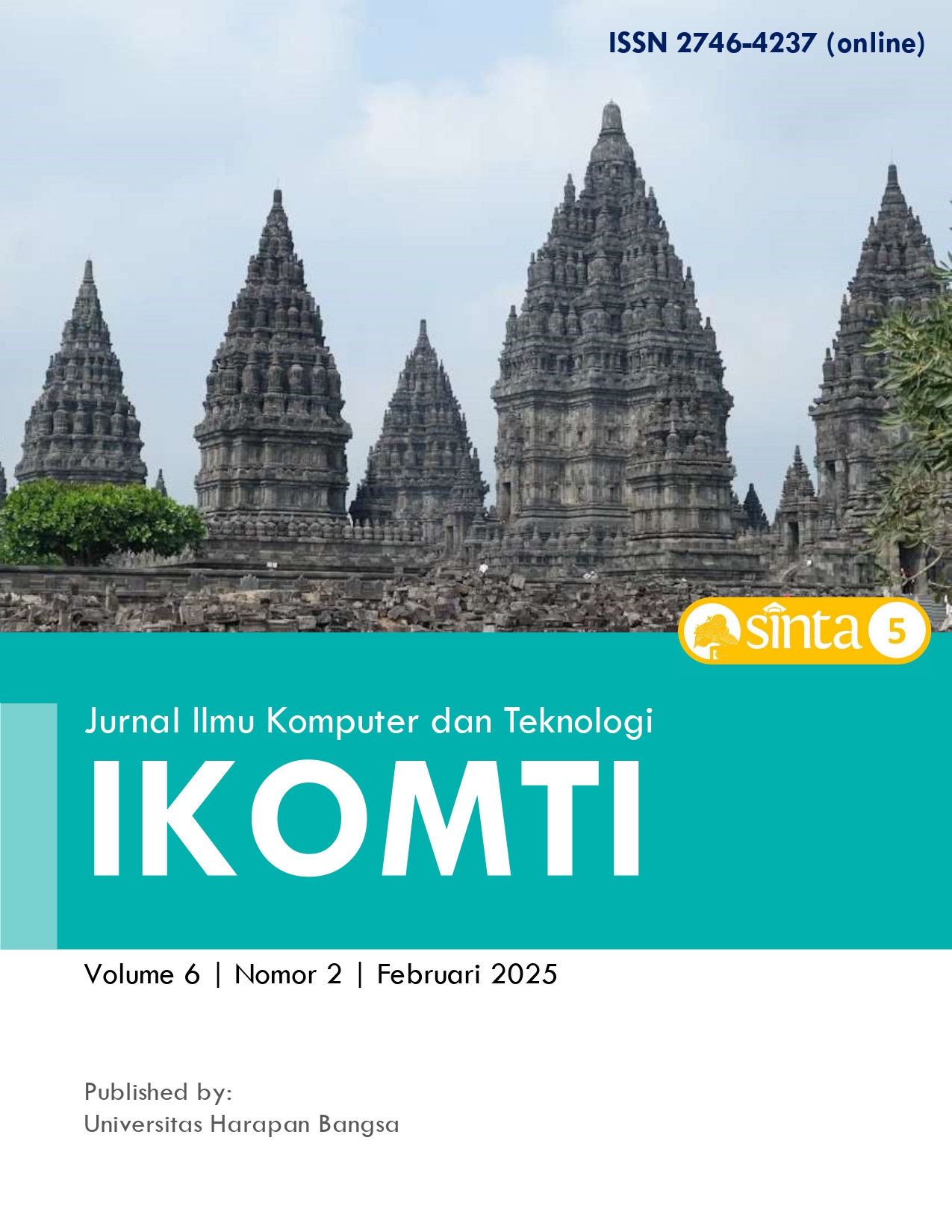Analisis AWS, Microsoft Azure, dan GCP terhadap Latency, Throughput, IAM, dan Firewall
DOI:
https://doi.org/10.35960/ikomti.v6i2.1795Keywords:
cloud services, network latency, throughput, response time, response speed, Identity and Access Management, firewallAbstract
This study evaluates the performance and security of Amazon Web Services (AWS), Microsoft Azure, and Google Cloud Platform (GCP) through technical testing and user experience surveys. Testing with Apache JMeter reveals that GCP has the highest throughput (61.7 bps) and best speed, while AWS has the lowest response time (38.16 ms) and Latency (507 ms). Performance data is presented in tables and graphs. In terms of security, AWS and Azure offer comprehensive features including role-based access control and multi-factor authentication, while GCP emphasizes network protection. Reliability analysis using Cronbach’s Alpha indicates excellent internal consistency (α > 0.9), with ANOVA tests showing significant differences in Throughput, Speed, and Firewall among providers, while other parameters show no significant differences. The findings provide insights into the strengths and weaknesses of each Cloud service provider.
References
[1] M. Saraswat and R. C. Tripathi, “Cloud Computing: Comparison and Analysis of Cloud Service Providers-AWs, Microsoft and Google,” in Proceedings of the 2020 9th International Conference on System Modeling and Advancement in Research Trends, SMART 2020, Institute of Electrical and Electronics Engineers Inc., Dec. 2020, pp. 281–285. doi: 10.1109/SMART50582.2020.9337100.
[2] V. Viji Rajendran and S. Swamynathan, “Parameters for comparing cloud service providers: A comprehensive analysis,” in Proceedings of the International Conference on Communication and Electronics Systems, ICCES 2016, 2016. doi: 10.1109/CESYS.2016.7889826.
[3] B. Allen, “The History of Google Cloud Platform.” Accessed: Jul. 08, 2024. [Online]. Available: https://www.gocoding.org/id/sejarah-google-cloud/
[4] Sutiono, “Apa itu Microsoft Azure ?” Accessed: Jul. 08, 2024. [Online]. Available: https://dosenit.com/software/microsoft/apa-itu-microsoft-azure
[5] R. Subekti, D. A. Ohyver, L. Judijanto, and I. Kadek, Transformasi Digital : Teori & Implementasi menuju Era Society 5.0. Jambi: PT. Sonpedia Publishing Indonesia, 2024. [Online]. Available: https://www.researchgate.net/publication/380462238
[6] A. Mondal, S. Paul, R. T. Goswami, and S. Nath, “Cloud computing security issues challenges: A Review,” in 2020 International Conference on Computer Communication and Informatics, ICCCI 2020, Institute of Electrical and Electronics Engineers Inc., Jan. 2020. doi: 10.1109/ICCCI48352.2020.9104155.
[7] K. Hashizume, D. G. Rosado, E. Fernández-Medina, and E. B. Fernandez, “An analysis of security issues for cloud computing,” Journal of Internet Services and Applications, vol. 4, no. 1, pp. 1–13, 2013, doi: 10.1186/1869-0238-4-5.
[8] ENISA, “Cloud computing: benefits, risks and recommendations for information security,” 2019. [Online]. Available: http://www.enisa.europa.eu/act/rm/files/deliverables/cloud-computing-risk-assessment/at_download/fullReport4http://www.enisa.europa.eu/act/rm/files/deliverables/cloud-computing-sme-survey
[9] U. Sumirat, A. D. Setiawan, S. Wilyanti, and R. R. Al-Hakim, “Analysis of Distributed File System Replication Using the NDLC Method with Hyper-V Virtual Simulation Machine,” SaNa: Journal of Blockchain, NFTs and Metaverse Technology, vol. 1, no. 1, pp. 10–22, 2023, doi: 10.58905/sana.v1i1.59.
[10] N. F. Soelaiman, S. S. S. Ahmad, O. Mohd, R. R. Al Hakim, and H. A. Hidayah, “Modeling the civil servant discipline in Indonesia: partial least square-structural equation modeling approach,” Asean International Journal of Business, vol. 1, no. 1, pp. 43–58, 2022, doi: 10.54099/aijb.v1i1.72.
[11] Z. Awang, A. Afthanorhan, and M. Mamat, “The Likert scale analysis using parametric based Structural Equation Modeling (SEM),” Computational Methods in Social Sciences, vol. 1, pp. 13–21, 2016, [Online]. Available: https://www.ceeol.com/search/article-detail?id=418522
[12] P. Dutta and P. Dutta, “Comparative Study of Cloud Services Offered by Amazon, Microsoft & Google,” International Journal of Trend in Scientific Research and Development (ijtsrd), no. 3, pp. 981–985, 2019, [Online]. Available: http://creativecommons.org/licenses/by/4.0
[13] I. Saeed, S. Baras, and H. Hajjdiab, “Security and Privacy of AWS S3 and Azure Blob Storage Services,” 2019 IEEE 4th International Conference on Computer and Communication Systems, 2019.
[14] S. Chopra, A. Nayyar, G. Singh, and R. Sharma, “AWS Tools and Services to Manage Cloud Security Concerns,” 2023. [Online]. Available: https://www.researchgate.net/publication/373195398
[15] A. Rath, B. Spasic, N. Boucart, and P. Thiran, “Security pattern for cloud SaaS: From system and data security to privacy case study in AWS and azure,” Computers, vol. 8, no. 2, Jun. 2019, doi: 10.3390/computers8020034.
[16] J. Nordman, “Google Cloud and solution for industrial automation systems,” University of Turku, 2020.
[17] Microsoft, “Microsoft Azure”, Accessed: Jul. 10, 2024. [Online]. Available: Https://azure.microsoft.com/en-in/free/cloud- services/
[18] Google, “Google Cloud Platform.” Accessed: Jul. 10, 2024. [Online]. Available: https://cloud.google.com/gcp/
[19] AWS, “AWS.” Accessed: Jul. 08, 2024. [Online]. Available: https://aws.amazon.com/about-aws/
Downloads
Published
How to Cite
Issue
Section
License
Copyright (c) 2025 Ichsani Nurul Islam, Antonius Darma Setiawan, Ariep Jaenul, Sidik Mulyono, Revita Desi Hertin, Aryo Satrio Wibowo, Khoirun Nisa, Sony Kartika Wibisono (Author)

This work is licensed under a Creative Commons Attribution 4.0 International License.













